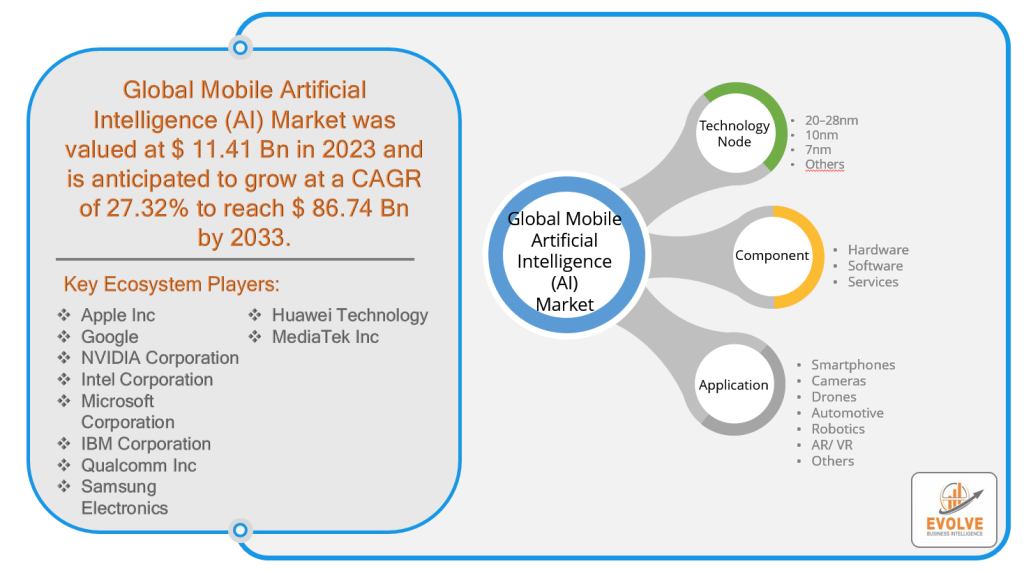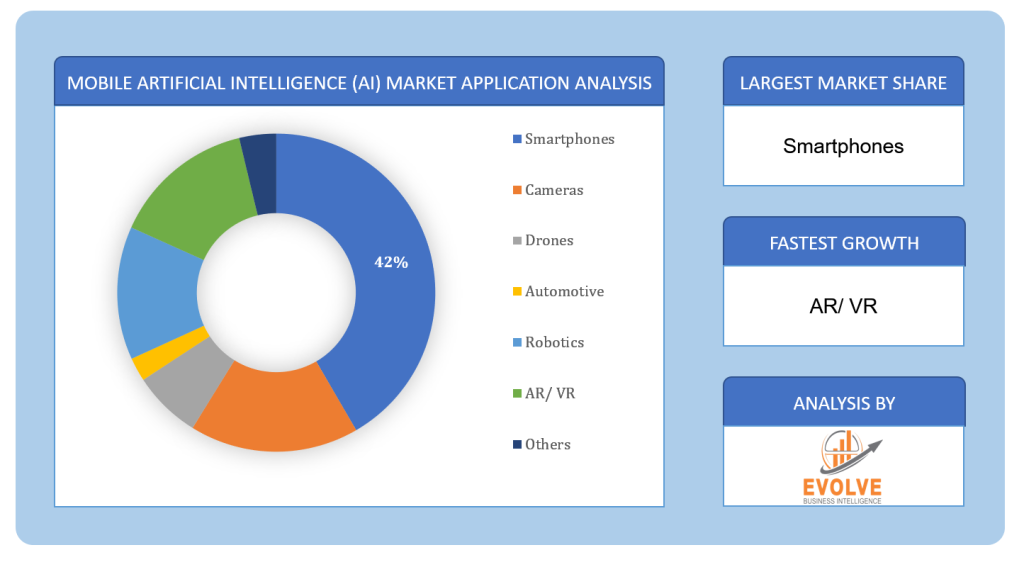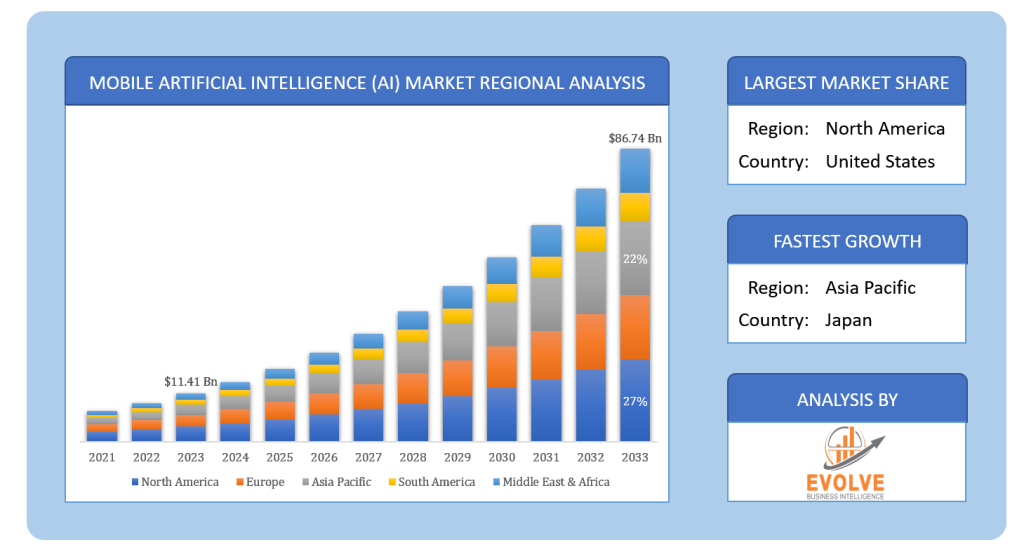Mobile Artificial Intelligence (AI) Market Size is expected to reach USD 86.74 Billion by 2033. The Mobile Artificial Intelligence (AI) industry size accounted for USD 11.41 Billion in 2023 and is expected to expand at a compound annual growth rate (CAGR) of 27.32% from 2023 to 2033. Mobile Artificial Intelligence (AI) refers to the implementation of AI technologies and algorithms on mobile devices such as smartphones, tablets, and other portable devices. It involves the integration of AI capabilities directly into mobile applications and operating systems, enabling on-device processing and decision-making without relying heavily on cloud-based services. Mobile AI leverages machine learning, natural language processing, computer vision, and other AI techniques to enhance the functionality, intelligence, and efficiency of mobile devices. By leveraging the power of AI locally on mobile devices, tasks such as voice recognition, image recognition, language translation, personal assistants, and predictive analytics can be performed in real-time, offering users personalized and context-aware experiences. Mobile AI enables devices to adapt and learn from user behavior, optimize performance, and deliver intelligent and interactive features, all while operating within the constraints of limited processing power and resources inherent in mobile devices.
Global Mobile Artificial Intelligence (AI) Market Synopsis
COVID-19 Impact Analysis
The COVID-19 pandemic had a significant positive impact on the Mobile Artificial Intelligence (AI) market. With the outbreak of the pandemic, there has been an increased reliance on mobile devices for communication, remote work, and accessing essential services. This surge in mobile usage has accelerated the adoption of Mobile AI as organizations and individuals seek innovative ways to enhance productivity, improve user experiences, and automate tasks. Mobile AI technologies, such as voice assistants, virtual agents, and chatbots, have played a crucial role in providing remote assistance, delivering personalized information, and supporting customer interactions in various sectors like healthcare, e-commerce, and education. Additionally, Mobile AI has been instrumental in enabling contactless interactions, facilitating facial recognition for touchless authentication, and supporting AI-driven surveillance systems for social distancing and crowd management. The pandemic has further highlighted the importance and potential of Mobile AI, driving its growth and shaping the future of mobile technology.
Global Mobile Artificial Intelligence (AI) Market Dynamics
The major factors that have impacted the growth of Mobile Artificial Intelligence (AI) are as follows:
Drivers:
Increased Mobile Computing Power
Mobile Artificial Intelligence (AI) market is a significant improvement in mobile computing power. Advancements in mobile processor technologies, coupled with higher RAM and storage capacities, enable mobile devices to handle complex AI algorithms and process large amounts of data efficiently. The increased computing power allows for real-time AI applications, such as voice recognition, image processing, and natural language processing, directly on mobile devices, enhancing user experiences and enabling new AI-driven functionalities.
Restraint:
- Limited Resources and Battery Life
A key restraint in the Mobile AI market is the limited resources and battery life of mobile devices. Implementing resource-intensive AI algorithms on mobile devices can consume significant computational power and drain the device’s battery quickly. This limitation poses challenges in providing continuous AI functionalities without compromising the device’s performance or user experience. Balancing the need for AI capabilities while optimizing resource utilization and managing power consumption remains a constraint in the widespread adoption and scalability of Mobile AI applications.
Opportunity:
⮚ Personalized User Experiences
The Mobile AI market presents an opportunity to deliver personalized user experiences. By leveraging AI algorithms and machine learning models directly on mobile devices, organizations can analyze user behavior, preferences, and contextual data to provide tailored recommendations, content, and services. Mobile AI enables intelligent and proactive interactions, offering users personalized assistance, predictive suggestions, and customized interfaces. This opportunity enhances user engagement, satisfaction, and loyalty, ultimately driving the adoption and growth of AI-powered mobile applications in various sectors, including e-commerce, entertainment, healthcare, and digital assistants.
Mobile Artificial Intelligence (AI) Market Segment Overview
By Technology Node
Based on the Technology Node, the market is segmented based on 20–28nm, 10nm, 7nm, and Others. The largest market share is anticipated to go to the 10nm segment. The adoption of advanced semiconductor fabrication processes, such as 10nm, has been a trend in the mobile industry to enhance the performance, power efficiency, and integration capabilities of mobile AI chips.
By Component
Based on Components, the market has been divided into Hardware, Software, and Services. The Hardware segment is expected to hold the largest market share in the Market. The demand for powerful and efficient hardware solutions with high computing capabilities has increased with the growing adoption of AI on mobile devices. Advancements in semiconductor technology, such as the development of smaller process nodes (10nm, 7nm), have enabled the integration of AI-specific chips into mobile devices, providing enhanced AI performance while minimizing power consumption.
By Application
Based on Application, the market has been divided into Smartphones, Cameras, Drones, Automotive, Robotics, AR/ VR, and Others. The market is projected to see significant growth in the Smartphone segment. smartphones have become an integral part of people’s lives, serving as the primary device for communication, entertainment, and accessing various digital services. The increasing demand for smartphones, coupled with the rising adoption of AI technologies, fuels the growth of AI-enabled smartphones. These devices incorporate AI capabilities directly into the hardware and software, enabling advanced features such as voice assistants, image recognition, and augmented reality experiences.
Global Mobile Artificial Intelligence (AI) Market Regional Analysis
Based on region, the market has been divided into North America, Europe, Asia-Pacific, the Middle East & Africa, and Latin America. The area of North America is anticipated to dominate the market for the usage of Mobile Artificial Intelligence (AI), followed by those in Asia-Pacific and Europe.
North America leads the highest market share in the Mobile Artificial Intelligence (AI) market. North America is home to several prominent technology companies and research institutions at the forefront of AI advancements. This region has a robust ecosystem for innovation, investment, and development of AI technologies, including mobile AI applications. Additionally, North America has a high adoption rate of smartphones and mobile devices, creating a large user base for mobile AI applications. The region’s strong infrastructure and advanced telecommunications networks also support the seamless integration and efficient operation of AI technologies on mobile devices. Moreover, North American businesses across various industries, such as healthcare, finance, retail, and entertainment, are actively leveraging mobile AI to enhance customer experiences, optimize operations, and gain a competitive edge.
Asia Pacific Market
The Asia-Pacific region had been witnessing a growing CAGR in the Mobile Artificial Intelligence (AI) industry. The region is home to a large population, including a significant number of tech-savvy individuals who are early adopters of mobile technologies. The increasing smartphone penetration and internet connectivity in countries such as China, India, South Korea, and Japan have created a substantial user base for mobile AI applications. Additionally, the Asia-Pacific region has a thriving startup ecosystem, with many innovative companies focusing on AI development and mobile technologies. The availability of skilled talent, government initiatives supporting AI research and development, and favorable investment environments have further fueled the growth of the Mobile AI industry in the region. Furthermore, the increasing digitalization of industries such as e-commerce, healthcare, and finance in the Asia-Pacific region has created opportunities for mobile AI applications, driving the demand for AI-powered mobile solutions.
Competitive Landscape
The competitive landscape includes key players (tier 1, tier 2, and local) having a presence across the globe. Companies such as Intel Corporation, Microsoft Corporation, IBM Corporation, Qualcomm Inc, and Apple inc are some of the leading players in the global Mobile Artificial Intelligence (AI) Industry. These players have adopted partnership, acquisition, expansion, and new product development, among others as their key strategies.
Key Market Players:
- Apple Inc
- NVIDIA Corporation
- Intel Corporation
- Microsoft Corporation
- IBM Corporation
- Qualcomm Inc
- Samsung Electronics
- Huawei Technology
- MediaTek Inc
Key Development:
In 2021, Google has been focusing on enhancing its mobile AI capabilities with the development and improvement of its AI-powered virtual assistant, Google Assistant. The company has been investing in natural language processing, machine learning, and voice recognition technologies to provide more personalized and intuitive experiences on mobile devices.
In 2021, Apple has been emphasizing the integration of AI technologies into its mobile devices, particularly with its Neural Engine and Core ML frameworks. These frameworks enable developers to implement AI models directly on Apple devices, enhancing on-device processing and privacy while providing users with powerful AI-driven features and functionalities.
Scope of the Report
Global Mobile Artificial Intelligence (AI) Market, by Technology Node
- 20–28nm
- 10nm
- 7nm
- Others
Global Mobile Artificial Intelligence (AI) Market, by Component
- Hardware
- Software
- Services
Global Mobile Artificial Intelligence (AI) Market, by Application
- Smartphones
- Cameras
- Drones
- Automotive
- Robotics
- AR/ VR
- Others
Global Mobile Artificial Intelligence (AI) Market, by Region
- North America
- US
- Canada
- Mexico
- Europe
- UK
- Germany
- France
- Italy
- Spain
- Benelux
- Nordic
- Rest of Europe
- Asia Pacific
- China
- Japan
- South Korea
- Indonesia
- Austalia
- Malaysia
- India
- Rest of Asia Pacific
- South America
- Brazil
- Argentina
- Rest of South America
- Middle East & Africa
- Saudi Arabia
- UAE
- Egypt
- South Africa
- Rest of Middle East & Africa
| Parameters | Indicators |
|---|---|
| Market Size | 2033: $86.74 Billion |
| CAGR | 27.32% CAGR (2023-2033) |
| Base year | 2022 |
| Forecast Period | 2023-2033 |
| Historical Data | 2021 |
| Report Coverage | Revenue Forecast, Competitive Landscape, Growth Factors, and Trends |
| Key Segmentations | Technology Node, Component, Application |
| Geographies Covered | North America, Europe, Asia-Pacific, Latin America, Middle East, Africa |
| Key Vendors | Apple Inc, Google, NVIDIA Corporation, Intel Corporation, Microsoft Corporation, IBM Corporation, Qualcomm Inc, Samsung Electronics, Huawei Technology, MediaTek Inc |
| Key Market Opportunities | Development of innovative AI-powered mobile applications and services Integration of AI algorithms directly on mobile devices for real-time processing Enhanced user experiences through personalized recommendations and intelligent interactions Market growth is driven by emerging economies and increasing smartphone penetration |
| Key Market Drivers | Increasing adoption of smartphones and mobile devices Advancements in mobile computing power and hardware capabilities Growing demand for personalized and intelligent mobile experiences Expansion of AI applications in various industries, such as healthcare, e-commerce, and entertainment |
REPORT CONTENT BRIEF:
- High-level analysis of the current and future Mobile Artificial Intelligence (AI) Industry trends and opportunities
- Detailed analysis of current market drivers, restraining factors, and opportunities analysis in the future
- Historical market size for the year 2021, and forecast from 2023 to 2033
- Mobile Artificial Intelligence (AI) market share analysis for each segment
- Competitor analysis with a comprehensive insight into its product segment, financial strength, and strategies adopted.
- Identifies key strategies adopted by the key players including new product development, mergers and acquisitions, joint ventures, collaborations, and partnerships.
- To identify and understand the various factors involved in the global Mobile Artificial Intelligence (AI) market affected by the pandemic
- To provide year-on-year growth from 2022 to 2033
- To provide short-term, long-term, and overall CAGR comparison from 2022 to 2033.
- Provide Total Addressable Market (TAM) for the Global Mobile Artificial Intelligence (AI) Market.








